Well! You spotted vibrant an orange-breasted bird and can’t tell what it is. Your confusion is genuine as it can be an oriole, a tanager or a robin.
This article will help you learn the characteristics of 21 orange-breasted birds in a nuanced way so that the next time you spot one such bird, you can immediately tell what it is.
It is possible for the birds mentioned in this article to have partially orange or fully orange bodies. These may be an assortment of orange hues, including vivid orange, muted orange, and others as well.
Also, you’ll discover the habitat, nutrition, nesting practices, and things the bird likes to consume at the feeder.
Size Comparison Chart
Size comparison helps a lot in telling two different species from one another. We have compiled the data on height, weight and wingspan of some common birds with orange bellies. Refer to the table below:
| Common Name | Scientific Name | Height | Weight | Wingspan |
| Altamira Oriole | Icterus gularis | 9.8 inches | 2.3 ounces | 14.2 inches |
| American Redstart | Setophaga ruticilla | 5.1 inches | 0.3 ounces | 7.5 inches |
| American Robin | Turdus migratorius | 11 inches | 3 ounces | 15.8 inches |
| Baltimore Oriole | Icterus galbula | 7.5 inches | 1.4 ounces | 11.8 inches |
| Blackburnian Warbler | Setophaga fusca | 4.7 inches | 0.4 ounces | 9.1 inches |
| Black-headed Grosbeak | Pheucticus melanocephalus | 7.5 inches | 1.7 ounces | 12.6 inches |
| Bullock’s Oriole | Icterus bullockii | 7.5 inches | 1.5 ounces | 12.2 inches |
| Eastern Towhee | Pipilo erythrophthalmus | 8.2 inches | 1.8 ounces | 11 inches |
| Hooded Oriole | Icterus cucullatus | 7.9 inches | 0.8 ounces | 11 inches |
| Orchard Oriole | Icterus spurius | 7.1 inches | 1 ounce | 9.8 inches |
| Red-winged Blackbird | Agelaius phoeniceus | 9.1 inches | 2.7 ounces | 15.8 inches |
| Spotted Towhee | Pipilo maculatus | 8.3 inches | 1.7 ounces | 11 inches |
| Varied Thrush | Ixoreus naevius | 10.2 inches | 3.5 ounces | 15 inches |
| Vermillion Flycatcher | Pyrocephalus rubinus | 5.4 inches | 0.5 ounces | |
| Western Tanager | Piranga ludoviciana | 7.5 inches | 1.3 ounces | |
| Flame-colored Tanager | Piranga bidentata | 7.5 inches | 1.39 ounce | 12 inches |
| Varied Thrush | Ixoreus naevius | 10.2 inches | 3.5 ounce | 15.0 inches |
| Western Spindalis | Spindalis zena | 5.9 inches | 0.74 ounce | 9.5 inches |
| Allen’s Hummingbird | Selasphorus sasin | 3.5 inches | 0.1 ounce | 4.3 inches |
| American Woodcock | Scolopax minor | 12.2 inches | 8 ounces | 18.9 inches |
| Barn Swallow | Hirundo rustica | 7.5 inches | 0.7 ounce | 1.6 inches |
1. Red-winged Blackbird
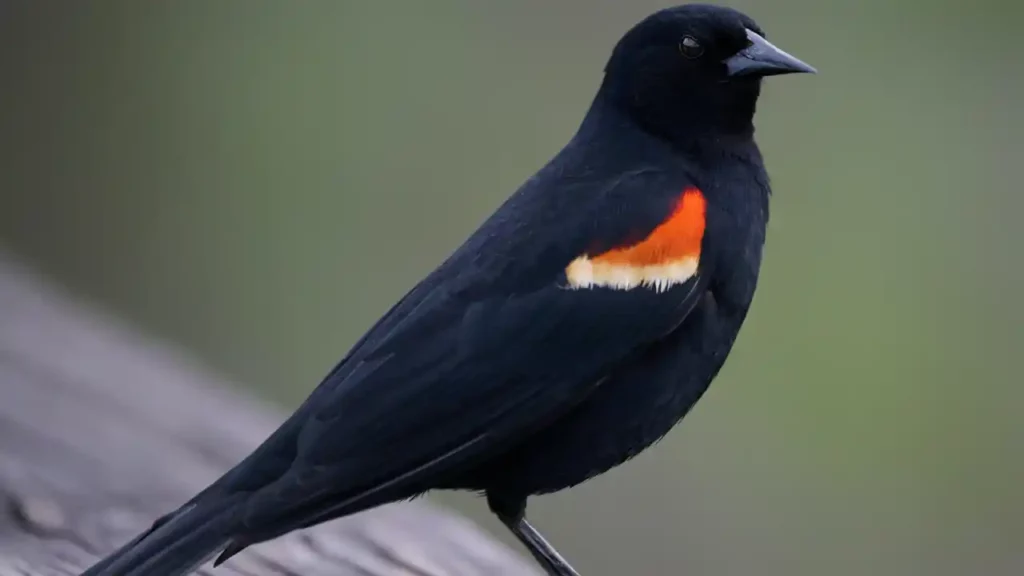
Red winged blackbirds have shining black bodies with yellow shoulder patches.
The females of the species resemble a big, black sparrow with their muted, streaky brown coloring. They joyfully announce the arrival of spring with their early and tumbling singing.
- Length: 6.7-9.1 in (17-23 cm)
- Weight: 1.1-2.7 oz (32-77 g)
- Wingspan: 12.2-15.8 in (31-40 cm)
Red-winged Blackbirds build their nests in forests next to streams. They gather in farm fields, feedlots, pastures, and grasslands during the autumn and winter.
Red-winged Blackbirds mostly consume insects in the summer and seeds in the winter, especially corn and wheat.
Using their thin bills, they will occasionally pierce the roots of aquatic plants to extract insects that are concealed inside.
They consume discarded grains, native sunflower seeds, and weedy seeds like ragweed in the fall and winter.
2. Baltimore Oriole

The vivid orange feathers on adult male Baltimore orioles’ underparts and shoulders give them a distinctive color that makes them easy to identify.
With their yellowish-orange and dark grey or brown feathers, females and immature males are less stunning in appearance. Long legs and pointed beaks are traits shared by males and females.
- Length: 6.7-7.5 in (17-19 cm)
- Weight: 1.1-1.4 oz (30-40 g)
- Wingspan: 9.1-11.8 in (23-30 cm)
Baltimore orioles can be spotted throughout eastern America and all the way west up to Montana.
Later in the summer or early in the fall, migratory populations go south, where they spend the remainder of the year in the Southeast United States, Central America, or South America.
Throughout the summer, Baltimore orioles predominantly consume insects; but, in the autumn, they convert to nectar and fruit, choosing to consume bright-colored fruits.
Most farmers view Baltimore orioles as pests, but they really do much more good than damage since they consume a lot of caterpillar larvae, which can destroy trees if their populations aren’t controlled.
They enjoy open deciduous forests as their habitat. Baltimore orioles thrive in metropolitan backyards and public parks as well.
They often construct nests in cottonwoods, and maples and hunt in the canopy of the trees.
Predators including squirrels, owls, big birds, and house cats pose a particular threat to their eggs and hatched fledglings. Adults fight back by raising warning cries and encircling predators.
3. Bullock’s Oriole

Bullock’s Orioles are colorful, striking birds at all phases of development. Mature males have a big white wing patch on their back and a predominantly orange face with a black eyeline.
Females have a noticeably dimmer overall appearance, with primarily grey on the belly and rich orange on the face.
Immature males seem identical to females, but with a little brighter appearance with a black neck and eyeline.
- Length: 6.7-7.5 in (17-19 cm)
- Weight: 1.0-1.5 oz (29-43 g)
- Wingspan: 12.2 in (31 cm)
Bullock’s Orioles nest in riverside and grassy woodland habitats, including city parks. They like regions where the plants are huge and spread widely apart, or where they grow in solitary groups.
During migration and winter, they prefer open woodland settings, but they can also be spotted in pine, pine-oak, or fir woods.
Bullock’s Orioles consume insects, fruit, and nectar. They collect bugs off leaves, twigs, and stems, as well as cobwebs in the air, and ripened fruit from shrubs and trees.
4. Hooded Oriole
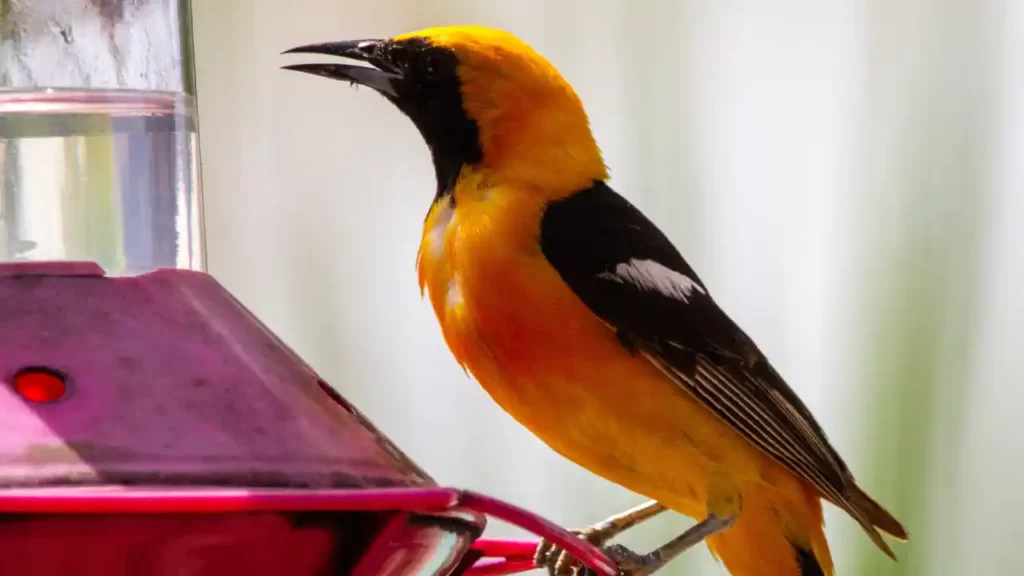
The hooded oriole measures around seven inches long. The male has two white stripes on his black wings and a tail that ranges from yellow to orange.
Its face, neck, and long, slender, curved black bill are all black. The female has a grayish-green upper body and yellow undersides.
Her wings are likewise embellished with two white bands.
- Length: 7.1-7.9 in (18-20 cm)
- Weight: 0.8 oz (24 g)
- Wingspan: 9.1-11.0 in (23-28 cm)
The breeding range of the hooded oriole extends south into northern Mexico from northern coastal and central California, southern Nevada, central Arizona, and western Texas.
The hooded oriole inhabits open woodlands as well as regions with palm trees, mesquite, or dry bushes. It frequently resides close to ranches and cities and may also be found in deciduous and riparian woods.
The hooded oriole consumes fruit and nectar in addition to insects, which make up the majority of its diet. Using its pointed bill, it cuts into the roots of tubular blooms to get nectar.
5. Orchard Oriole
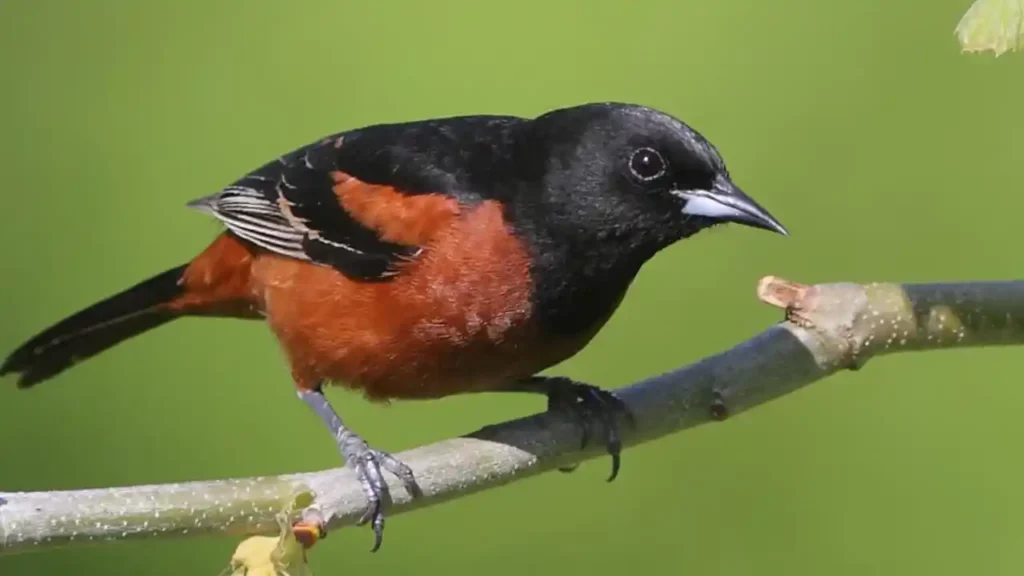
Orchard orioles are small-sized orioles. Male adults have a distinctive, deep chestnut-brown hue and a black head.
Females have white wing bars and are a drab yellow-green color. Male immatures resemble females but have a black neck and mask instead.
- Length : 5.9-7.1 in (15-18 cm)
- Weight: 0.6-1.0 oz (16-28 g)
- Wingspan: 9.8 in (25 cm)
Orchard orioles like to settle close to a body of water, such as a lake or river, and can be found in marshes, confined riparian zones, or floodplains.
Breeding orchard orioles may be found in Mexico, the United States, and Canada.
The orchard orioles’ winter range extends from northern South America through Central America, including both coastlines of Mexico.
Orchard orioles are largely insectivorous during the mating season; however, they also eat small, ripe fruits and berries, nectar, and tiny seeds.
Insects make up around most of their diet while plant matter makes up about some
6. Altamira Oriole
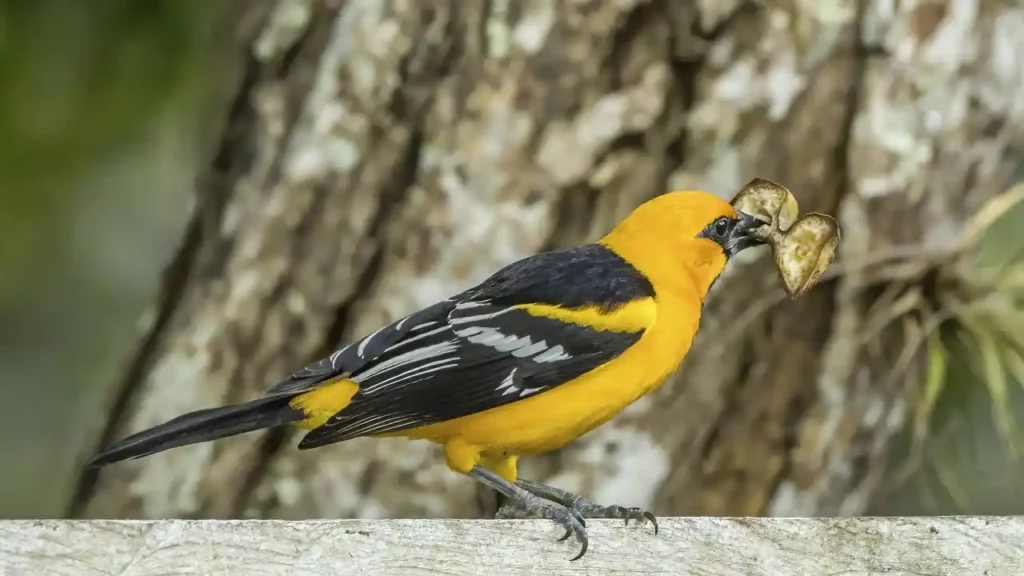
The large brilliant orange oriole has a strong, black beak and an orange belly. There is only a little black on the face and throat; the back and wings are black with a white wingbar and an orange shoulder patch. Juvenile birds have a duller yellow color.
Altamira orioles resemble Hooded Oriole, which is bigger, stockier, and has an orange shoulder patch and a thicker beak.
- Length: 8.3-9.8 in (21-25 cm)
- Weight: 1.7-2.3 oz (47-64 g)
- Wingspan: 14.2 in (36 cm)
Most Altamira orioles are insectivores. They do, however, enjoy eating fruit and drinking nectar.
Due to their enormous size and bill shape, it is hypothesised that they may occasionally ingest seeds and nuts. Insects and larvae are the primary foods for nestlings.
7. Spot-breasted Oriole

Spot breasted orioles are a medium-sized songbird with a bright orange head. They have black on their forehead, bib, back, and tail.
Similar to adults in appearance but milder in color, their juveniles have olive-green backs and tails, dusky wings, and little to no black on their faces, throats, or breasts.
- Length: 8.3-9.4 in (21-24 cm)
- Weight: 1.8 oz (50 g)
Spot-breasted Orioles can be found in suburban settings with a dense population of tropical landscaping plants in the tiny imported U.S. range in Florida.
They can be found in dry forests and prickly scrublands in their natural habitat of Central America.
Spot breasted orioles consume a lot of insects as well as fruits and berries. They will also consume flower nectar.
While foraging, it moves slowly through the plants and foliage in search of insects and fruit.
Moreover, they will go to flower patches and frequently destroy the blossoms at the base to get to the nectar.
8. Streak-backed Oriole
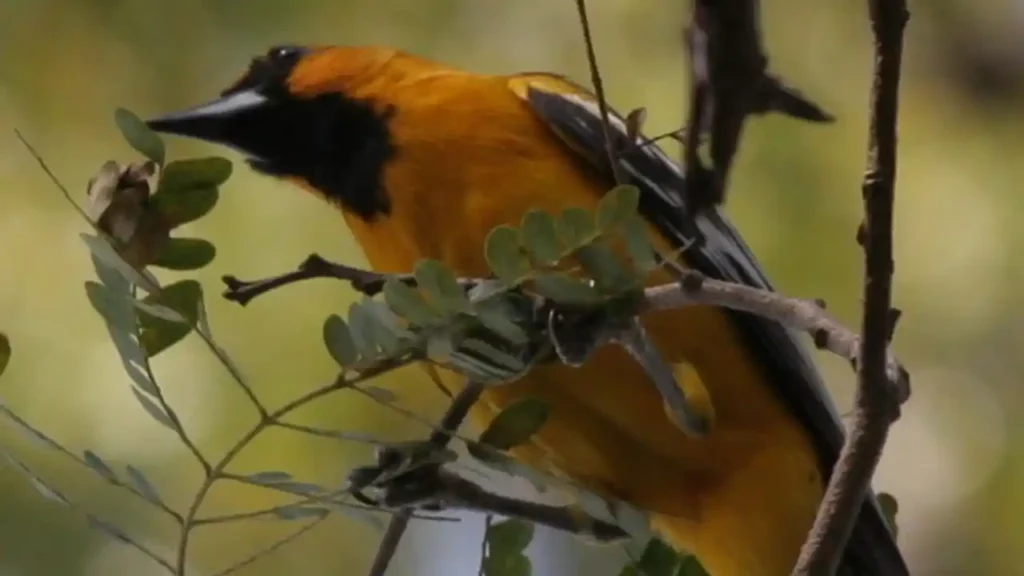
Males of the northern Streak-backed Oriole population have bright salmon- to reddish-orange heads, earning them the nickname Flame-headed Oriole at one time.
Streak-backed orioles typically have black or orange to yellow back sides; their very crimson color and this species’ striped rump are not usual.
Strike backed oriole has a range that covers the majority of the Pacific coast from northwest Mexico, to Central America, northern Sonora, and western Chihuahua.
You may see this vividly colored orange bird near rivers or other water bodies often. It has been recognised as a migrant to some states in the southwestern US.
9. American Redstart
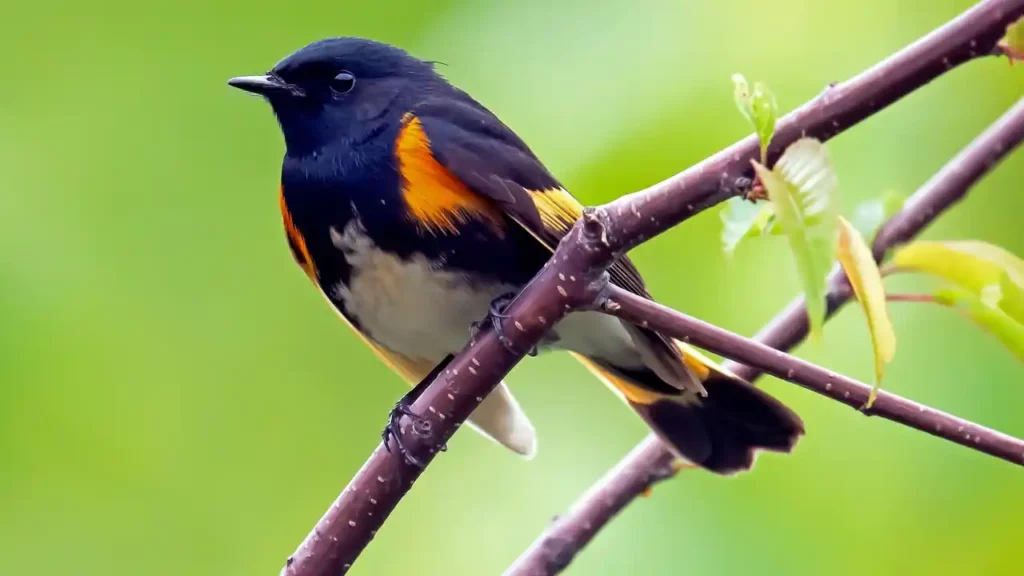
American redstarts are part of the warbler family. With the exception of enormous orangish spots on their wings and tails, males in mating feathers are distinctive; they are pitch black above. While the majority of their underparts are white, their chest sides are also orange.
- Length: 4.3-5.1 in (11-13 cm)
- Weight: 0.2-0.3 oz (6-9 g)
- Wingspan: 6.3-7.5 in (16-19 cm)
Breeding grounds for American redstarts are located in southern Canada and the eastern US. They migrate, spending the winters in Central America, the West Indies, and northern South America. They are extremely uncommon birds in western Europe.
Redstarts typically obtain their meal through flycatching, although they may also glean it off leaves. Insects make up virtually all of their diet.
They frequently coexist in foraging areas with other warblers and typically eat in the middle to lower reaches of a tree or bush.
10. American Robin
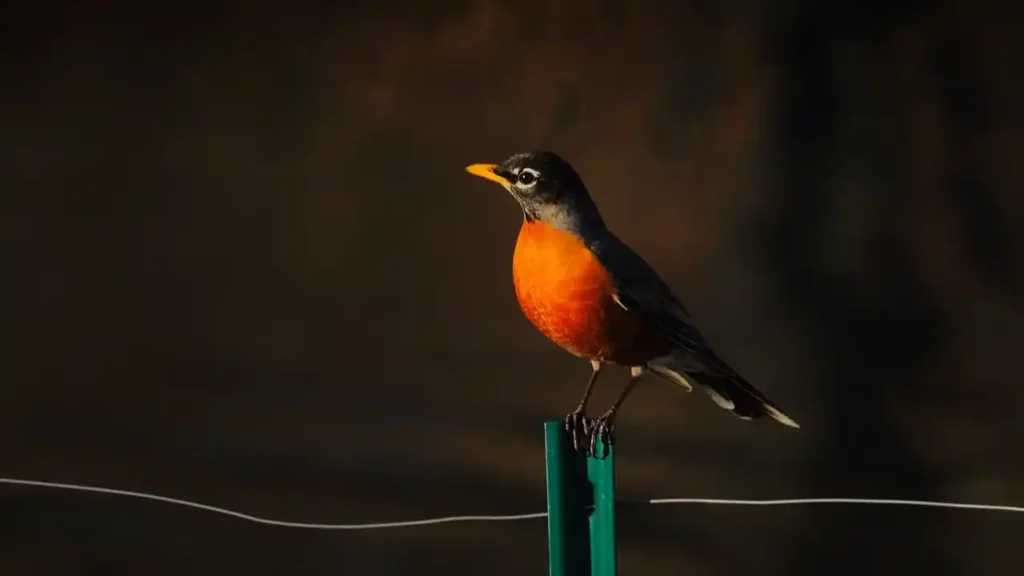
American Robin has a somewhat yellowish beak, and a long tail. Its back is a deep gray-brown color, and its breast is rusty orange with no streaks. The eye seems to have a shattered eye ring due to the white blotches surrounding it. While females are less vividly colored, males and females seem identical. The young are visible, much like the young of the majority of other thrushes.
- Length: 7.9-11.0 in (20-28 cm)
- Weight: 2.7-3.0 oz (77-85 g)
- Wingspan: 12.2-15.8 in (31-40 cm)
Throughout sections of Central America as well as all of North America, American robins may be found. Open grassy spaces, gardens, and wooded areas are all good places to look for them. Connecticut, Michigan, and Wisconsin each have this species as their official state bird.
The American robin consumes a diverse range of foods, such as berries, fruits, worms, and caterpillars. Its primary food source in winter is berries. It frequently appears in fields at the dawn in search of invertebrates such as worms and grubs.
11. Eastern Towhee
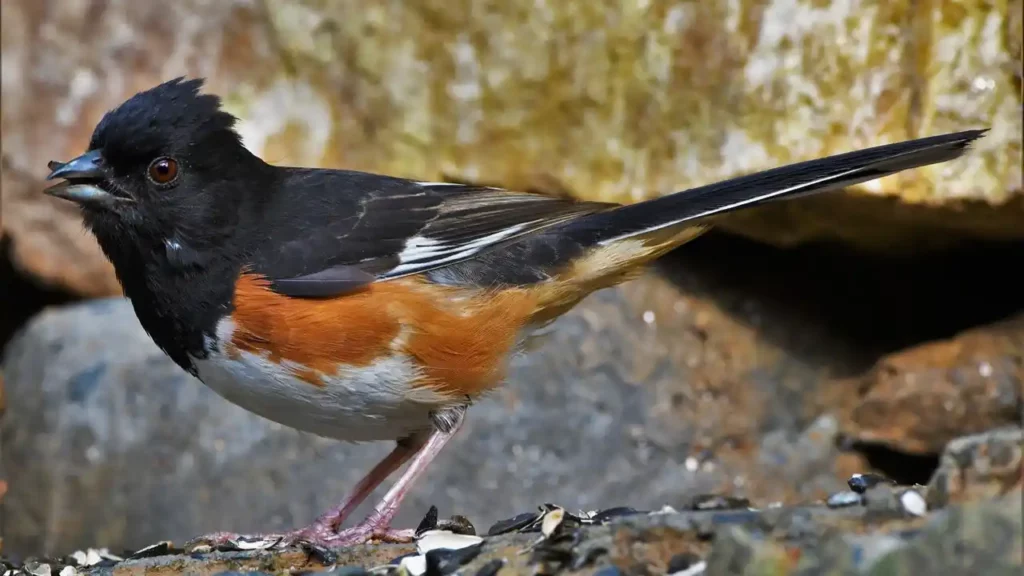
A thick black cloak covering the head, back, and breasts and lowering down to the chest in a U- or V-shape is characteristic of eastern towhees. White corners on the black tail show conspicuously when flying. The belly is white, while the flanks have a striking rusty hue. The undertail coverts have a buff or very light red color.
- Length: 6.8-8.2 in (17.3-20.8 cm)
- Weight: 1.1-1.8 oz (32-52 g)
- Wingspan: 7.9-11.0 in (20-28 cm)
Eastern towhees spend the whole year in the Southeast and Midwest America, then during the summer they move to the Northeast and the Great Lakes region. This species like pastures, savannahs, and wooded areas with bushes. They choose areas with lots of grass and vegetation so they can look for food.
Eastern towhees devote the majority of their time sitting on the ground or on low bushes hunting for seeds, insects, and fruit. Using their feet, the birds scrape the ground in search of food that has been hidden beneath debris or leaves. The large beak of the eastern towhee aids in breaking open seeds. Moreover, the bird occasionally consumes tiny salamanders, lizards, or snakes. It also consumes spiders, snails, and millipedes.
12. Spotted Towhee
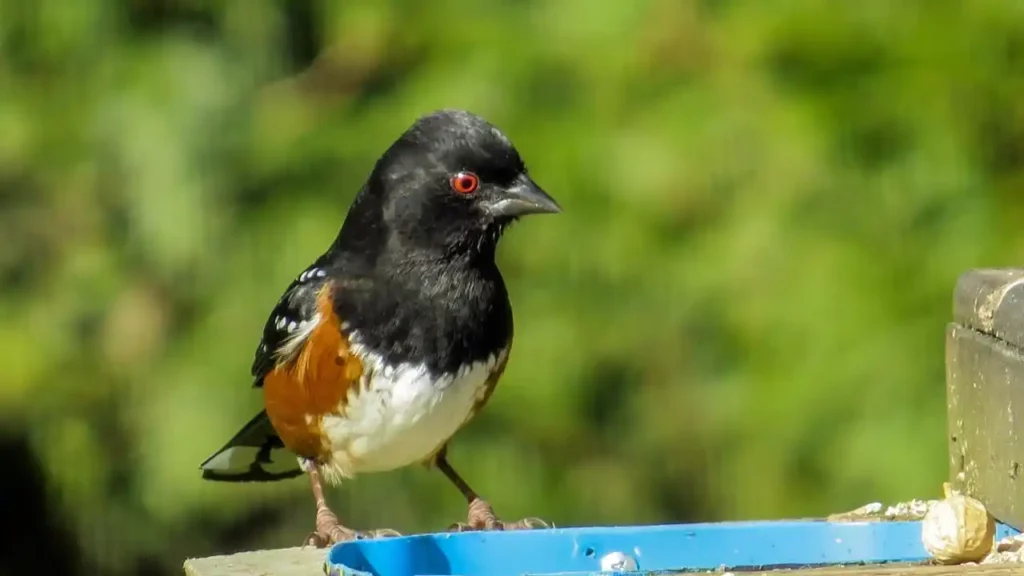
The Spotted Towhee features glossy red eyes, pale pink limbs, and a long, black fan-shaped tail with white edges.
Mature males frequently have a white belly, reddish flanks, white markings on their rear, and white wing bands along with a slightly brighter head, upper torso, and tail.
Females have a similar appearance, although they are dark brown and grey rather than black.
Spotted towhees may be found all throughout western North America during the breeding season. Certain birds fly eastward, primarily to the northwest-central Great Plains of the United States.
Certain groups may relocate to lower elevations during the wintertime in other regions.
They are energetic during the day and spend a lot of time looking for food. They rummage loudly among dry leaves in search of insects as they graze on low vegetation.
When startled, they bury themselves deep under the foliage, wait patiently for a while, and then resume foraging. When feeders are present in their forest environment, spotted towhees usually visit them as well.
13. Blackburnian Warbler
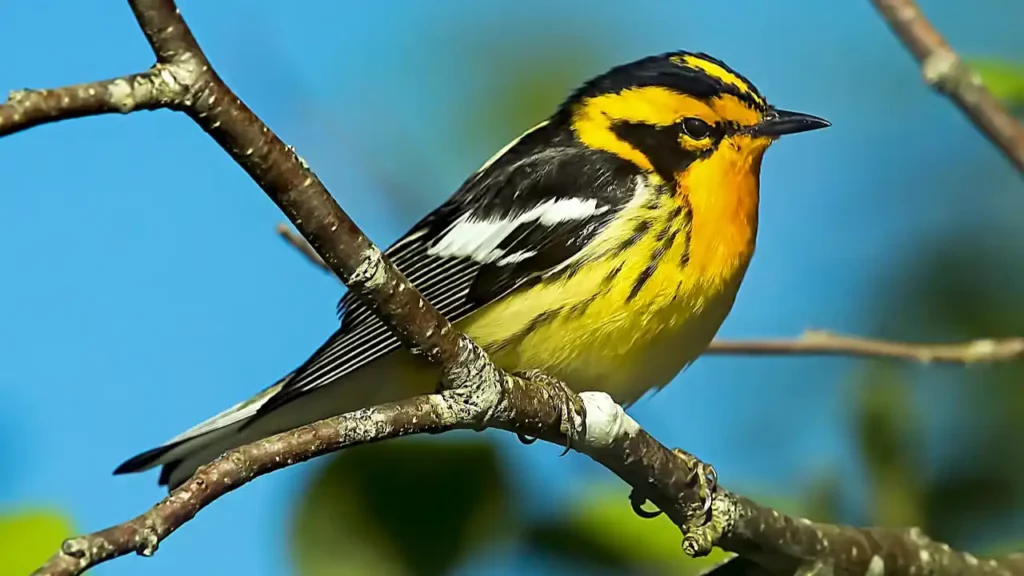
Eastern North America is home to the little, colorful Blackburnian Warbler.
Males have double white wing stripes, dark brown heads, and dark grey backs in the summer. They also have golden rumps.
These birds’ white underparts are tinted with yellow and have black streaks running across them.
A raging neck is paired with a head that is heavily decorated in black and yellow.
- Length: 4.3-4.7 in (11-12 cm)
- Weight: 0.3-0.4 oz (8.9-12.6 g)
- Wingspan: 7.9-9.1 in (20-23 cm)
Breeding grounds for blackburnian warblers extend from southern Canada westward to the Great Lakes area, New England, and North Carolina. They migrate, spending the winters in southern Central and South America, and are extremely uncommon in western Europe.
Blackburnian Warblers eat insects. They prefer eating caterpillars, although they also consume moths, butterflies, beetles, ants, flies, and spiders. Berry consumption increases throughout the winter.
14. Brambling
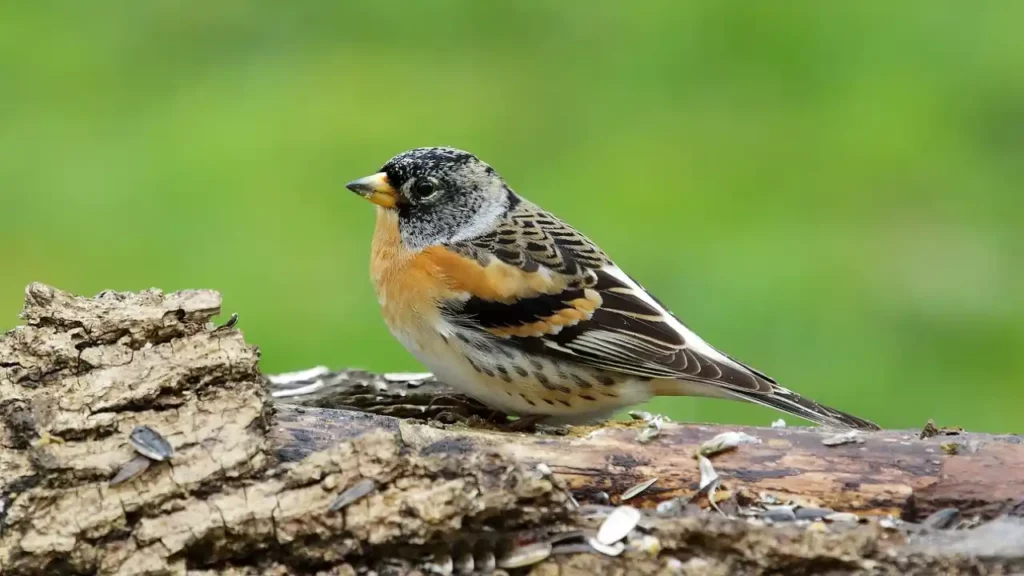
The Brambling has a completely black head, a lighter neck, and orange markings on the chin, neck, and chest. With some black spots on the sides, the underparts are white.
Female Bramblings seem like faded males, but their wings and tails are darker. The nape is a lighter shade of grey and is visible on the rear of the head as a distinguishing patch.
The back, top, and flanks of the neck are all dark brown. Grey-brown with a wide border on the forehead and chin.
- Length: 16 cm
- Weight: 23-29 g
- Wingspan: 25–26 cm
In the UK, they may be found in every sort of environment, including towns, farms, parks, and gardens. In order to spend the winter in our milder environment, migrant brambles begin to come around October.
Bramblings typically eat from bird tables and the ground, but they may occasionally steal food from the bird feeders. Garden Bramblings enjoy seed mixtures.
15. Black-headed Grosbeak
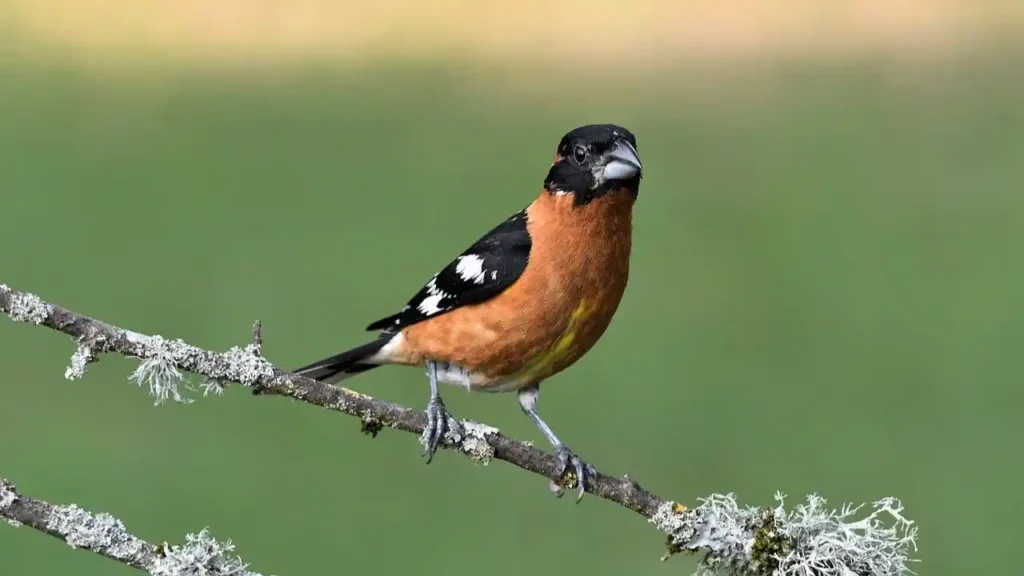
Black-headed Grosbeaks have strong, slender beaks. The male is very appealing, sporting a black head, reddish orange breast, neck, and rear, a black back, feathers, and tails, as well as white spots on its wings.
In flight, it is possible to observe the white outer flight feathers and the yellow underparts of this bird.
- Length: 7.1-7.5 in (18-19 cm)
- Weight: 1.2-1.7 oz (35-49 g)
- Wingspan: 12.6 in (32 cm)
Black-headed grosbeaks like deciduous trees and broad-leaved evergreen forests. They build their nests in tiny trees or bushes that line the margins of open forests, ponds, marshes, or rivers.
During the mating season, black-headed grosbeaks mostly consume insects and other larvae, such as crickets, moths, caterpillars, beetles.
They consume tiny fruits as well, including cherries, raspberries, strawberries, as well as buds and seeds that they can easily split open with their strong bill.
16. Northern Red Bishop

Breeding males possess this distinctive plumage, which makes them northern red bishops.
Comparable to the feathers pattern of a song sparrow, the females and non-breeding males have a diluted brown and white color scheme.
When the breeding season begins, males change to this vivid and colorful plumage. But, towards the end of the breeding season, they moult these showy feathers to develop feathers that look more like that of the females.
Natural habitats for northern red bishops include Mauritania, Guinea-Bissau, Mali, Sierra Leone, Liberia, Burkina Faso, Ivory Coast, Ghana, Togo, Benin, Nigeria, Chad, and Cameroon.
17. Western Tanager
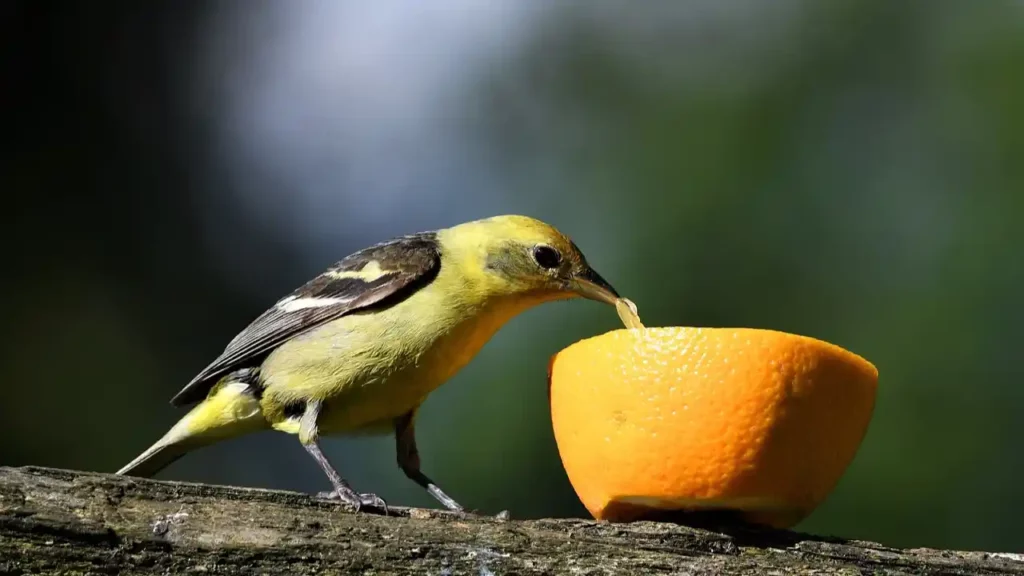
Western Tanagers’ bills are medium in thickness. The heads of adult males are orange-red with brilliant yellow bodies. The majority of this bird’s plumage is yellow, with two black wing bars and tails.
Males who are fully grown have complete black markings, while females and young animals have grey or brown patterns. Males have two wing-bars, one on each wing, one white and one yellow.
Alaska, Baja California, Mexico, the western coast of North America hosts breeding grounds for western tanagers.
Their habitat ranges from eastern Oklahoma to western Texas, and from southern Canada’s Northwest Territories to northern New Mexico.
During the mating season, it mostly eats insects, although it also occasionally includes fruits and berries in its diet.
Western Tanagers fly out to grab flying insects as well as collect insects from leaves and trees.
18. Scarlet Tanager
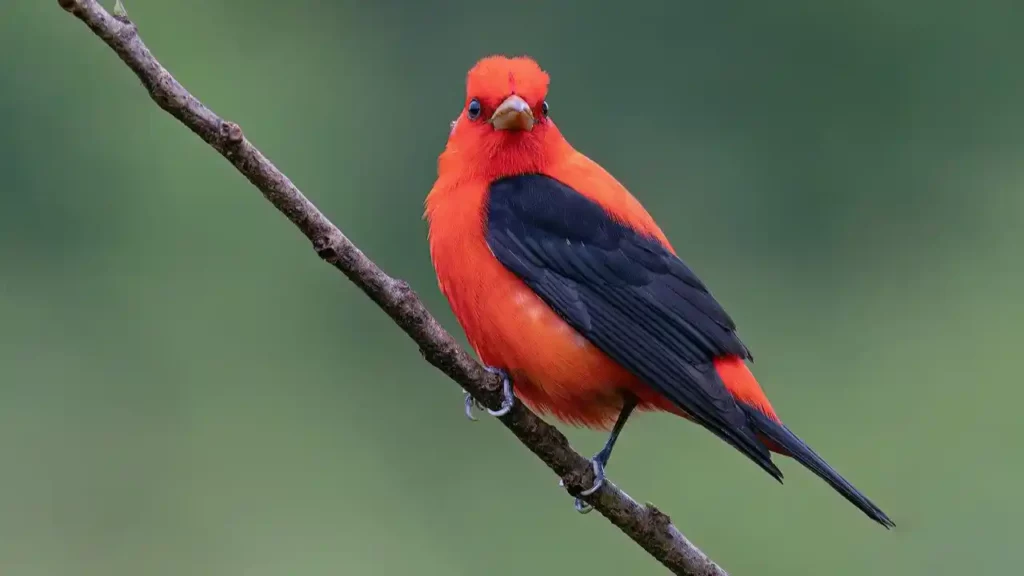
Western Tanager’s bills are smooth-textured, moderately thick, light in colour, and resemble horns. With black wings and tails, adult males are reddish-colored.
Females have olive-colored upperparts and yellowish underparts, as well as wings and tails that are yellow-olive in colour.
Despite the wings and tail continuing to be darker, the adult male’s winter appearance resembles that of the female.
Eastern North America is home to breeding scarlet tanagers, which migrate through Central America on their way to north-western South America for the winter.
In eastern North America, these birds can be found in great tracts of deciduous woodland, particularly those with oaks.
Their major diet consists of insects including bees, wasps, hornets, ants, and sawflies, as well as moths, butterflies, beetles.
They also consume grasshoppers and locusts. In addition to eating fruit, scarlet tanagers also eat snails, spiders, and worms.
19. Flame-colored Tanager

In west Mexico, males are flame-orange, whereas in east Mexico and Central America, they are darker orange-red.
Female Western Tanagers may be distinguished from females by their streaked back, larger white wing patterns, and grey beak.
- Length: (18 – 19 cm)
- Weight 1.13 – 1.71 oz (32 – 48 g).
They are very widespread in oak and pine-evergreen woods in the foothills and highlands; some migrate to west Mexico’s lowlands during the winter.
They forage mostly at intermediate to higher levels, which are frequently silent and easily unnoticed.
The Flame-colored Tanager flies quickly between trees and flaps its wings quickly while doing so. They do this when foraging, particularly in orchards since they enjoy fruit.
They collect insects off leaves and trees, although it’s unusual to witness them snatching them out of the air.
20. Varied Thrush

The Varied Thrush has a striking design. A black chest band separates the male’s rust-colored stomach and neck, while the female has a paler, grey band.
The ring that borders the face at the eye is similar. The back and tail are bluish grey, and the head has a rust-colored band over the eyeband.
Slate, black, and rust are vividly banded on the wings. Similar design is seen in females, although their backs are brown.
- Length: 7.5-10.2 in (19-26 cm)
- Weight: 2.3-3.5 oz (65-100 g)
- Wingspan: 13.4-15.0 in (34-38 cm)
Breeds in a variety of coniferous forests, although it is most prevalent along the coast in deep, wet forests with fir and spruce trees with a dense understory.
Coniferous forests are preferred during migration and winter, although it also occurs in the foliage of other woods, particularly those close to rivers.
Beetles, ants, caterpillars, crickets, and a wide variety of other insects are among the many insects that it consumes, particularly during the summer months.
It also consumes a large number of millipedes, sowbugs, snails, earthworms, spiders, and other crustaceans.
21. Western Spindalis

The male is vividly colored, with a head that is laterally patterned in black and white and a neck, chest, and nape that are contrasted in scorched orange. The belly’s remaining area is pale grey.
Similar looking head patterns are present in the female; however, they are faded out to a medium grey color. They have a subtle orange wash across her chest, back, and shoulders.
Western Spindalis mostly consumes fruits and berries, but may occasionally consume soft leaf edges as well as other plant components.
During breeding, it stays in pairs; at other times, in small groups; it appears that bigger groups are flocked when hunting. It forages among low-lying bushes and tall trees.
The species may be discovered in the western Caribbean and southeast Florida,
Conclusion
We tried our best to document the most commonly found birds with orange chests in the States. We mentioned the factors essential for you to recognise them such as their appearance, distinguishing features from other closely resembling birds, and their habitat so you can be wary of any confusion next time you spot a bird of such appearance.


